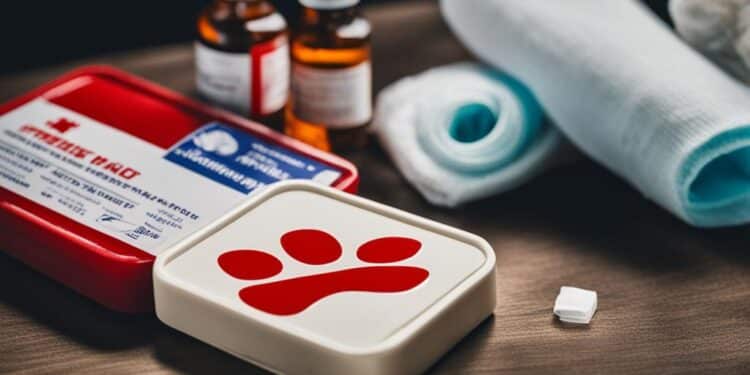Paws, Claws, and Emergencies: Canine First Aid Basics

Canine first aid is crucial for any dog owner to know. Whether it’s a minor cut or a more serious injury, being prepared to provide immediate care can make a significant difference in your furry friend’s well-being. Here are some essential canine first aid basics to help you safeguard your dog’s life in emergencies.
When it comes to your dog’s health, having a well-equipped dog first aid kit is essential for emergency preparedness. With the right supplies, you’ll be ready to handle common injuries and address emergencies promptly. Here are some key items to include in your dog first aid kit:
Creating a Dog First Aid Kit: Essentials for Emergency Preparedness
With the safety and well-being of your furry friend in mind, it’s crucial to have a well-equipped dog first aid kit on hand for any unexpected emergencies. Here are the essentials you should include in your kit to ensure you’re prepared for common injuries and emergencies.
Table: Dog First Aid Kit Essentials
| Item | Function |
|---|---|
| Sterile gauze pads and bandages | For wound dressing and covering |
| Adhesive tape | To secure bandages in place |
| Antiseptic wipes or solution | For cleaning wounds |
| Tweezers | To remove splinters or foreign objects |
| Scissors | For cutting bandages or fur if necessary |
| Digital thermometer | To monitor your dog’s temperature |
| Instant cold pack | To reduce swelling or inflammation |
| Disposable gloves | To protect yourself from potential infections |
| Emergency contact numbers | For your veterinarian and nearest animal hospital |
| Specific medications or treatments | Recommended by your veterinarian |
Having these essential items readily available in your dog first aid kit will allow you to provide prompt and effective care when your furry friend needs it most. Remember to regularly check the expiration dates of items in your kit and replace them as needed to ensure their efficacy.
Additionally, it’s beneficial to familiarize yourself with basic first aid techniques specific to common injuries in dogs. This knowledge will enable you to take immediate action before seeking professional veterinary assistance. Being proactive in your dog’s care can make a significant difference in their overall well-being.
Remember, while having a dog first aid kit is essential, it is not a substitute for professional veterinary care. Always consult your veterinarian for guidance in case of severe injuries or emergencies. Their expertise and assistance will ensure the best possible outcome for your beloved pet.
Handling Common Canine Injuries: Quick Tips for First Aid
While it’s essential to contact your veterinarian in case of a severe injury, you can provide immediate first aid in certain situations. Here are some quick tips for handling common canine injuries:
Cuts and Wounds
Gently clean the area with antiseptic solution or wipes and apply a sterile gauze pad or bandage.
Burns
Run cold water over the burn for at least 10 minutes and cover it with a sterile dressing.
Fractures
Immobilize the affected limb using a splint or makeshift support and take your dog to the vet as soon as possible.
Choking
If your dog is choking, try to remove the obstruction carefully. If unsuccessful, perform the Heimlich maneuver or seek veterinary assistance.
Heatstroke
Move your dog to a cooler area, apply cold water to their fur, and offer small sips of water. Seek veterinary help immediately.
Remember, these first aid tips are not substitutes for professional veterinary care. Always contact your veterinarian for guidance in case of a severe injury or emergency.
Conclusion: Be Prepared to Protect Your Furry Friend
Canine first aid is a crucial skill for every dog owner to possess. By familiarizing yourself with the basics of first aid and ensuring you have a well-stocked dog first aid kit, you can be prepared to provide immediate care in case of emergencies. Remember, your quick actions can make a significant difference in your furry friend’s well-being.
However, it’s important to note that these first aid tips are not substitutes for professional veterinary care. In case of severe injuries or emergencies, always contact your veterinarian for guidance and seek their assistance. They are the experts who can provide the necessary care your dog may require.
So, take the time to gather the essential items for your dog first aid kit and educate yourself on canine first aid basics. Your preparedness could potentially save your dog’s life in critical situations. Stay informed, stay prepared, and be the first responder your furry friend deserves!
FAQ
What items should I include in my dog first aid kit?
Some essential items to include in your dog first aid kit are sterile gauze pads, bandages, adhesive tape, antiseptic wipes or solution, tweezers, scissors, a digital thermometer, an instant cold pack, disposable gloves, emergency contact numbers for your veterinarian and nearest animal hospital, and any specific medications or treatments recommended by your veterinarian.
Can I provide first aid to my dog in certain situations?
Yes, in certain situations, you can provide immediate first aid to your dog. For cuts and wounds, clean the area with antiseptic solution or wipes and apply a sterile gauze pad or bandage. For burns, run cold water over the burn for at least 10 minutes and cover it with a sterile dressing. For fractures, immobilize the affected limb using a splint or makeshift support. If your dog is choking, try to remove the obstruction carefully or perform the Heimlich maneuver. In case of heatstroke, move your dog to a cooler area, apply cold water to their fur, and offer small sips of water. However, always contact your veterinarian for guidance and assistance in case of severe injuries or emergencies.
Is canine first aid a substitute for professional veterinary care?
No, canine first aid is not a substitute for professional veterinary care. While it is important to provide immediate first aid in certain situations, always contact your veterinarian for professional guidance and seek their assistance in case of severe injuries or emergencies.






